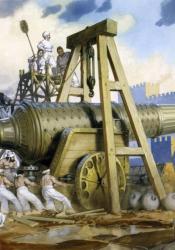The Siege of Constantinople
Often considered the end of the Middle Ages, the fall of the Byzantine Empire marks a significant shift from the medieval to the renaissance. Constantinople was constructed to be an impenetrable fortress able to withstand any siege. However, the Ottoman Empire made effective use of gunpowder and artillery to destroy the indestructible. Even the might of Constantinople was overcome by the Ottoman "super cannon," the Dardanelles gun. Weighing 16.8 tons and measuring 27 feet in length, the Dardannelles gun was capable of delivering crippling damage at a range of 1.5 miles. The siege engineer behind such a destructive power, Orban, was contracted by Sultan Mehmet II to produce a weapon strong enough to end Constantinople. Orban is quoted as saying, "I can cast a cannon of bronze with the capacity of the stone you want. I have examined the walls of the city in great detail. I can shatter to dust not only these walls with the stones from my gun, but the very walls of Babylon itself." Though the Dardanelles Gun was very effective in destroying the walls of Constantinople, it required large teams of men to operate, and could only be fired seven times per day to prevent cracking. Still, the Ottomans, armed with their superior siege weaponry, were able to bring about an end to the Christian Roman Empire. The destruction wrought by such a machine could not be described better than by a soldier in charge of firing the gun, who said, "And when it had caught fire, faster than you can say it, there was first a terrifying roar and a violent shaking of the ground beneath and for a great distance around, and a din such as has never been heard. Then, with a monstrous thundering and an awful explosion and a flame that illuminated everything round about and scorched it, the wooden wad was forced out by the hot blast of dry air and propelled the stone ball powerfully out. Projected with incredible force and power, the stone struck the wall, which it immediately shook and demolished, and it was itself shattered into many fragments, and the pieces were hurled everywhere, dealing death to those standing nearby."
Sources:
“The Guns of Constantinople.” HistoryNet, 13 Apr. 2016, www.historynet.com/the-guns-of-constantinople.htm.
Bunting, Tony. “Fall of Constantinople.” Encyclopædia Britannica, Encyclopædia Britannica, inc., 5 Sept. 2017, www.britannica.com/event/Fall-of-Constantinople-1453.
Kamel, Marwan. “Ottoman Super Cannon: The bombard that built an empire.” All About History, www.historyanswers.co.uk/medieval-renaissance/ottoman-super-cannon-the-b....

